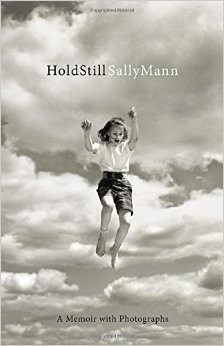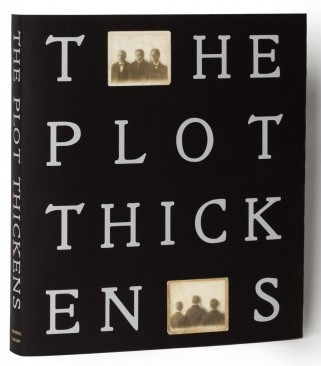Skinner Holds Photo Auction on Sept. 11th in Boston
Peabody Essex Museum appoints Kennel as Curator of Photography
Russell joins Heritage Auctions as Director of Photographs, NYC
Santa Barbara Museum Curator Karen Sinsheimer Dies of Cancer
Photo Books: From Julia Margaret Cameron to Sally Mann, and The Plot Thickens

JULIA MARGARET CAMERON: PHOTOGRAPHS TO ELECTRIFY YOU WITH DELIGHT AND STARTLE THE WORLD.
By Marta Weiss. MACK, in association with V&A Publishing, London. Accompanying the exhibition of the same name organized by the Victoria and Albert Museum, London, at the Art Gallery of New South Wales, Sydney, Australia, August 13-October 25, 2015; at the Victoria and Albert Museum, November 28, 2015-February 21, 2016; and other venues. 186 pgs; approximately 100 plates; softbound. ISBN No. 9781910164297. Information: http://www.mackbooks.co.uk.
It is fitting that London's Victoria and Albert Museum is launching this signal exhibition of Julia Margaret Cameron's portraiture: 2015 marks not only the bicentenary of her birth but also the 150th anniversary of her first museum show (the only one held in her lifetime), which also took place at the Victoria and Albert. This catalogue, with fine essays and organization by V&A photography curator Marta Weiss, explores the museum's unparalleled Cameron holdings, all albumen prints from wet collodion negatives, along with selections from her correspondence.
It's interesting to note how the familiar Cameron style--with its soft-focus, gently shadowed views of family, friends and the famous--was avant-garde in its day. Cameron was comfortable with the soft-focus, but also with the out-of-focus, as well as with showing the evidence of her process, including scratches and smudges. Weiss emphasizes that Cameron never doubted photography's status as an art form, and so her representations of women and children in delicate Madonna-and-child poses seem less like Pictorialist allegory and more a kind of performance art, marked by the realism of the sitters' faces and forms, and the sense of movement and life imparted by the variance of focus.
This strong sense of immediacy is just as evident in Cameron's portraiture of the famed, from Robert Browning to Charles Darwin or Alfred Lord Tennyson, and such superb images of female dignity and unadorned beauty as those of Julia Jackson or Lady Duckworth. And at her most theatrical, Cameron created truly startling images of mythological or religious figures--Circe, Cupid & Psyche, Hypatia, Sappho, St. Agnes--that leap at us with haunting eye contact and unforced suggestions of psychological depth. Indeed, the intimacy of personhood that Cameron achieved in her portraits remains powerfully unique, and sets them apart from other 19th-century work.
Weiss chronicles all this, and more, with first-rate scholarship, from Cameron's colorful biography (born in Calcutta to an East India Company official and a woman descended from French aristocracy) to the equanimity and confidence with which she endured the negative reviews of her work. Critics of the day struggled to accept that Cameron's versions of well-known paintings were not meant to duplicate so much as enact, less idealized than humanized. But there were a few contemporary critics who got it, as in an 1868 review noting that "the imperfections are generous and undisguised, and the very inequalities seem to point out at times the special beauties of her workmanship." And the jury of the 1865 Dublin Exhibition hailed Cameron as "a true artist," expressing a very progressive view: "The more Mrs. Cameron's productions are examined, the more they are appreciated."
All the same, Weiss suggests that it can be dangerous to assume too much, that it is "impossible to know the extent to which Cameron embraced…irregularities, which other photographers at the time would have rejected as technical flaws, or whether she merely tolerated them." But her willingness to experiment and her openness to aesthetic surprise are undeniable. Just as this important exhibition will be worth seeing at its various global stops, this fine catalogue provides the essential context for grasping the technique and trajectory of one of photography's great visionaries.

HOLD STILL: A MEMOIR WITH PHOTOGRAPHS.
By Sally Mann. Little, Brown. 482 pgs; hardbound; $32 US, $35 Canada. ISBN No. 978-0-316-24776-4. Information: http://www.littlebrown.com; http://www.sallymann.com.
The twilit aura that makes Sally Mann's photographs so evocative comes through just as strongly in her writing, to judge from her new memoir, "Hold Still." Widely known, admired, and collected for her ethereal studies of Southland settings and subjects, Mann is also a subject of controversy, infamous to some for her nude images of her children. But as daughter, wife, mother or American master, Mann is unapologetically herself, and she has much to say.
Not surprisingly, much of "Hold Still" is an artist's quest to make some sense of the past, including the murder-suicide of her husband and Larry Mann's parents. Born Sally Munger to an emotionally remote mother and an eccentric, death-obsessed country doctor, Mann can accept her parents' quiet oddity, but she is no morbid clone of her father. If anything, her matter-of-fact embrace of life and its complexities is the Southern charm and soft breeze of this book, which intersperses a trove of photography throughout the text.
Many are family snapshots, along with versions of some of her best-known images. They transform the book into a mixed-media project that complements and clarifies Mann's thoughts, especially when she takes on the critics who would censor her Edenic nude photos of her children. The result is something of a conversation with the artist, as she breaks her narrative with an invitation to "take a look at this picture," and allows us to share a purely visual point of view.
Sifting through boxes of family memorabilia and artful evidence with Mann feels at once voyeuristic and perfectly right, for Mann is so observant and determined to see through the surface of things that she persuades us to look deeper. Unfortunately, for those with a deeper interest in her photography, the book is somewhat challenged. Rather than provide a glossy insert of key photographs or at least a sampling of high-quality prints, the images scattered through the pages are reduced in size and typically low-fi versions on standard book paper.
This doesn't matter all that much when the artifacts are sundry family snapshots, or even her father's world-traveler photographs, taken when he was a young man. But it would be nice to have better reproductions of Mann's superb Southern landscapes, or of her best-known photos of her children–especially given that she provides numerous alternate and comparative versions that reveal her discerning artist's eye, as she notes the photos' frequent "genesis in a failed image but one that had some rudiment of the eternal in it." These glimpses of process are compelling, and they deserve an art-book treatment that a trade-book budget doesn't permit. Presented mainly as literature, though, "Hold Still" certainly holds together.

THE PLOT THICKENS. Published to accompany an exhibition at Fraenkel Gallery, San Francisco. Distributed by Artbook/D.A.P., New York. Hardbound; 200 pgs.; approximately 100 color and black-and-white plates. ISBN No. 978-1-881337-39-3. Information: http://www.artbook.com; http://www.fraenkelgallery.com.
This hefty, handsome, velvet-bound tome is one of the most entertaining and edifying art books of the year, celebrating a recent exhibition at San Francisco's venerable Fraenkel Gallery. Its raison d'etre is pithily articulated by gallery owner Jeffrey Fraenkel, who writes: "Photography's plot has been thickening since the first photographers made their second photographs. Now, 175 years later, the plot has so thickened that little consensus exists about what, exactly, a 'photograph' is. Fraenkel goes on to note that his gallery was born in 1979 as a bare-bones operation and "…well, let's settle for the fact that it's thickened."
There's not much else in the way of exegesis provided, other than that a dozen or so anonymous prints are included, and that most of the works on display were set aside over a five-year period to be exhibited and published by the gallery for the first time (indeed, Fraenkel unveils such a clearing house every five years). The results range wonderfully across decades and centuries, from, for example, Atget's 1922 "Poirier Fleurs" to an echoing (but more tonally complex) image of blossoms on a bough by Lee Friedlander in 2003.
Things move backward as well, from Diane Arbus's 1961exploration of Nancy Bellamy's spare, spooky bedroom, to Eadweard Muybridge's 1887 sequence of a nude man in various poses, to NASA photos from space, to Alex Soth's and Richard Misrach's postmodernist landscapes (including a 2011 Misrach "IPhone Study" of smashed pink eyeglasses in the street), to Walker Evans' 1974 image of Sankey's milk-bottle ice cream stand in Taunton, MA, (again paralleled by Friedlander's visitation of the same subject matter), and so on. But Fraenkel is careful to group the images thematically without straitjacketing them, so there's some order amid the aesthetic fragmentation.
Relatively few of photography's big names go unrepresented here, and the specimens are uniformly fascinating: Garry Winogrand at his best (a New York crowd dispersing like rays of light) and worst (a too-random panorama of trucks); Harry Callahan gently investigating sky and tree leaves; Nicholas Nixon drawn to the prosaic siding of a suburban home; more Arbus, more Friedlander; some essential Mike Disfarmer (a little girl posed like a celluloid doll); a black-and-white 1966 William Eggleston of a liquor store luridly night-lit; and so on. Ultimately, it is the anonymous images interspersed among the name brands that give this book its "frisson": a 1973 shot of a bank robber aiming his gun at a security camera (a dead-on image from the security camera itself) speaks volumes about the power of photography, even when executed by non-humans. The plot thickens, indeed.
BRIEFLY NOTED:

"LA GUERRE DES GOSSES" (Societe Francaise de Photographie; http://sfp.asso.fr/collection/index.php/guerre-des-gosses/le-livre) is a charming and somewhat chilling project from 1915, when French photojournalist Leon Gimpel outfitted and posed a number of children as soldiers enacting war games on Paris's rue Grenata. Gimpel was a skilled autochromist, and the portfolio contains some fine color shots. This French-English bilingual book of 36 pages includes an eight-page brochure reproducing the original text by Gimpel and a bonus image in its original size.

From FoMu (The Fotomuseum of Antwerp), "CAMERA EXOTICA: A WESTERN EUROPEAN VIEW OF THE WORLD IN PHOTOGRAPHY (1850-1960)" is part of a FoMu series that explores the museum's holdings from a thematic perspective, illuminating lesser-known trends in the medium. "Camera Exotica" covers a century in which western photographers--including those as famed as Henri Cartier-Bresson and Fulvio Roiter--represented foreign or "exotic" subjects as a narrative of ambiguity, reflecting the photographers' desires and anxieties that prevailed in industrialized societies as opposed to a more accurate picturing of foreign cultures and civilizations.
Happily, the photography that strives for anthropological accuracy, or seems to, prevails. Thus, the myriad shots of African tribespeople, Asian and Middle Eastern natives, and others posed nobly but not inaccurately are contrasted with more stereotypical images that represent the distortions of exotic representation, such as Greta Garbo as Mata Hari or Carmen Miranda in exaggerated headgear. Information: http://www.fotomuseum.be/en.html.
Matt Damsker is an author and critic, who has written about photography and the arts for the Los Angeles Times, Hartford Courant, Philadelphia Bulletin, Rolling Stone magazine and other publications. His book, "Rock Voices", was published in 1981 by St. Martin's Press. His essay in the book, "Marcus Doyle: Night Vision" was published in the fall of 2005. He currently reviews books for U.S.A. Today.
(Book publishers, authors and photography galleries/dealers may send review copies to us at: I Photo Central, 258 Inverness Circle, Chalfont, PA 18914. We do not guarantee that we will review all books or catalogues that we receive. Books must be aimed at photography collecting, not how-to books for photographers.)
Skinner Holds Photo Auction on Sept. 11th in Boston
Peabody Essex Museum appoints Kennel as Curator of Photography
Russell joins Heritage Auctions as Director of Photographs, NYC
Santa Barbara Museum Curator Karen Sinsheimer Dies of Cancer
Photo Books: From Julia Margaret Cameron to Sally Mann, and The Plot Thickens


Share This